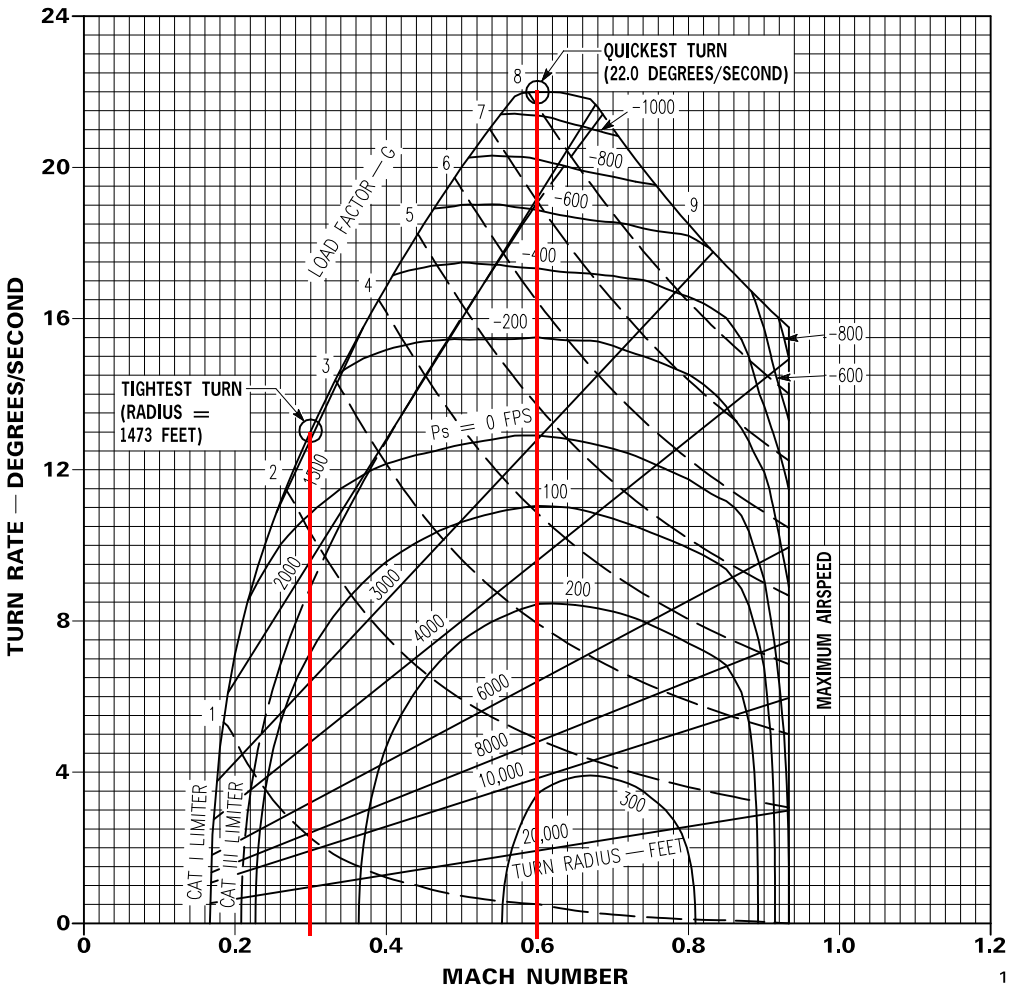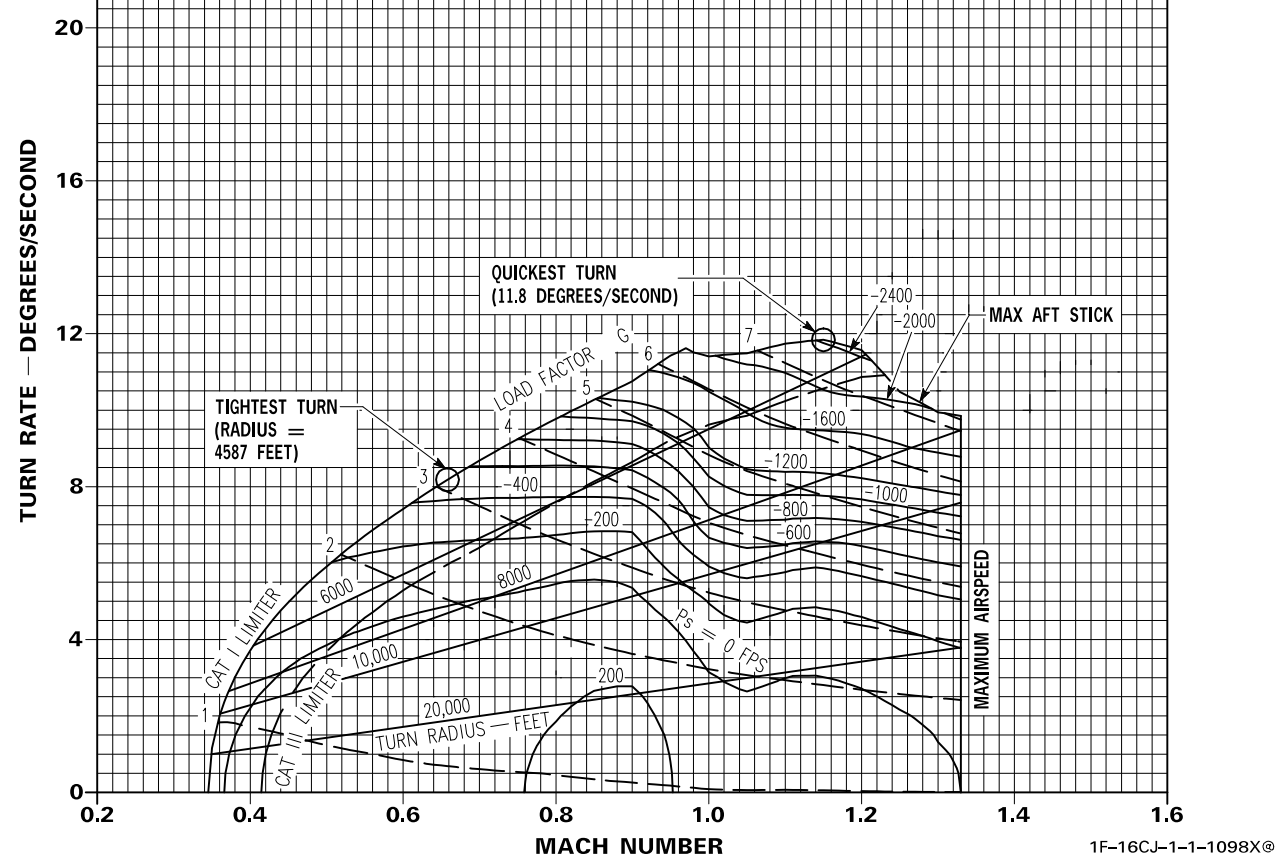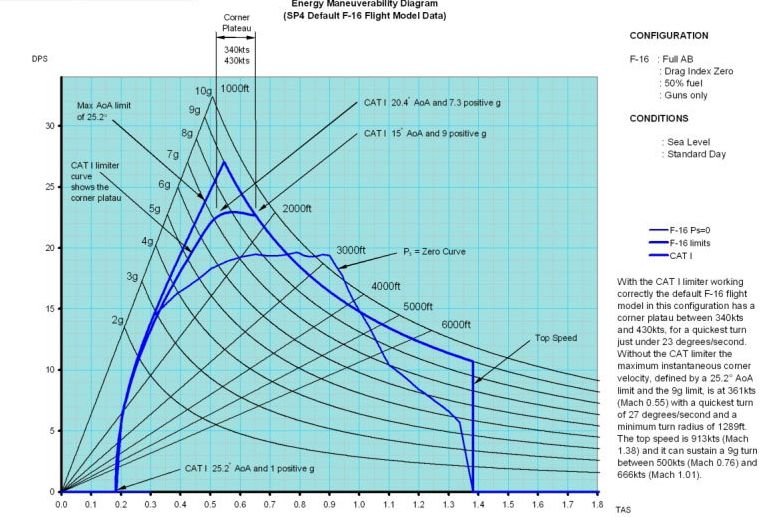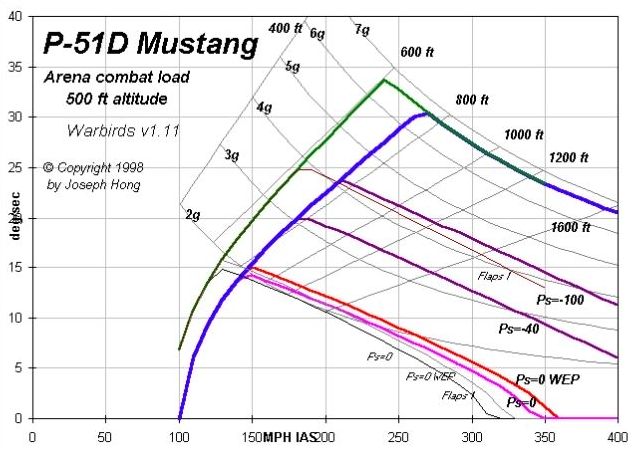Max Rate turn vs. Min Radius Turn
Join Date: Jul 2015
Location: NZ
Posts: 45
Likes: 0
Received 0 Likes
on
0 Posts
Apologies for digging up a old thread though it seems to be the most relevant.
I am trying to better understand the physics around max rate vs min radius turns. This is how I understand it currently:
Turn rate increases directly proportional to a decrease in TAS or an increase in radial G. Usually at Va and C/L Max or limiting characteristic approaching C/L Max. Note that Va is an IAS not TAS
Turn radius decreases proportional to the square of a decrease in TAS and directly proportional to an increase in radial G. It is usually somewhat slower that Va and at a lower G loading than max rate due to the square relationship with TAS while only proportional relationship to G Loading.
Now I look at two examples:
1. F16 26,000lbs Sea Level: (See Turn Performance chart below)
- Min Radius Turn: R1473ft, 13°/s @ 0.3M (198kt) AoB 67.1° 2.6G
- Max Rate Turn: R1756ft, 22°/s @ 0.6M (397kt) AoB 82.9° 8G
2. Theoretical Aerobatic a/c Vs 60kt, 8G, Va=170kt Sea Level:
- Min Radius Turn: R322ft, 51°/s @ 170kt AoB 82.9° 8G
- Max Rate Turn: R322ft, 51°/s @ 170kt AoB 82.9° 8G
- 2.6G for Ref. to F16 Min Radius Turn: R347ft, 27°/s @ 96kt AoB 67.1° 2.6G
Calculators:
Aircraft Turn Information Calculator
Aviation Calculator
Why does my theoretical aerobatic aircraft have the same Max Rate as Min Radius turn, while the F16 seems to fit my intuitive understanding better?
What am I missing folks?
Cheers!

F16 26000lbs DF 100 Sea Level
I am trying to better understand the physics around max rate vs min radius turns. This is how I understand it currently:
Turn rate increases directly proportional to a decrease in TAS or an increase in radial G. Usually at Va and C/L Max or limiting characteristic approaching C/L Max. Note that Va is an IAS not TAS
Turn radius decreases proportional to the square of a decrease in TAS and directly proportional to an increase in radial G. It is usually somewhat slower that Va and at a lower G loading than max rate due to the square relationship with TAS while only proportional relationship to G Loading.
Now I look at two examples:
1. F16 26,000lbs Sea Level: (See Turn Performance chart below)
- Min Radius Turn: R1473ft, 13°/s @ 0.3M (198kt) AoB 67.1° 2.6G
- Max Rate Turn: R1756ft, 22°/s @ 0.6M (397kt) AoB 82.9° 8G
2. Theoretical Aerobatic a/c Vs 60kt, 8G, Va=170kt Sea Level:
- Min Radius Turn: R322ft, 51°/s @ 170kt AoB 82.9° 8G
- Max Rate Turn: R322ft, 51°/s @ 170kt AoB 82.9° 8G
- 2.6G for Ref. to F16 Min Radius Turn: R347ft, 27°/s @ 96kt AoB 67.1° 2.6G
Calculators:
Aircraft Turn Information Calculator
Aviation Calculator
Why does my theoretical aerobatic aircraft have the same Max Rate as Min Radius turn, while the F16 seems to fit my intuitive understanding better?
What am I missing folks?
Cheers!

F16 26000lbs DF 100 Sea Level
Join Date: Jul 2015
Location: NZ
Posts: 45
Likes: 0
Received 0 Likes
on
0 Posts
Flown F16s or F/A-18s, no. Flown (back seat) FJ, and studied combat performance, yes.
Max rate and min radius are both primarily down - in any continuous turn - to available excess thrust in a fast jet, particularly at lower altitudes. Higher up you can turn potential energy into continuous turn rate - but clearly will lose height doing so.
Instantaneous are down to the stall margins - but almost always there's not enough thrust to sustain what the wing can, indefinitely.
G
Max rate and min radius are both primarily down - in any continuous turn - to available excess thrust in a fast jet, particularly at lower altitudes. Higher up you can turn potential energy into continuous turn rate - but clearly will lose height doing so.
Instantaneous are down to the stall margins - but almost always there's not enough thrust to sustain what the wing can, indefinitely.
G
Last edited by Genghis the Engineer; 12th Nov 2018 at 15:22.
Join Date: Jul 2015
Location: NZ
Posts: 45
Likes: 0
Received 0 Likes
on
0 Posts
Flown F16s or F/A-18s, no. Flown (back seat) FJ, and studied combat performance, yes.
Max rate and min radius are both primarily down - in any continuous turn - to available excess thrust in a fast jet, particularly at lower altitudes. Higher up you can turn potential energy into continuous turn rate - but clearly will lose height doing so.
Instantaneous are down to the stall margins - but almost always there's not enough thrust to sustain what the wing can, indefinitely.
G
Max rate and min radius are both primarily down - in any continuous turn - to available excess thrust in a fast jet, particularly at lower altitudes. Higher up you can turn potential energy into continuous turn rate - but clearly will lose height doing so.
Instantaneous are down to the stall margins - but almost always there's not enough thrust to sustain what the wing can, indefinitely.
G
So back to square one? It looks like that even with potential energy accounted there is still a huge spread between Max Rate and Min Radius... 8G vs 2.6G
Guaranteed I am missing something here. Just not sure what it is or even if I have already said it...
We seem to agree that a maximum rate turn is achieved when maximum lift is achieved at the aircraft load limit. Practically speaking pulling light buffet at the aircraft's limiting 'g'. Only very high performance aircraft will be able to sustain this in level flight without the speed decreasing and if the speed decreases then the light buffet will no longer achieve limiting 'g', hence a need to descend and sustain the speed.
Theoretically the best radius of turn will be achieved at the slowest speed and the highest load factor, in other words if an aircraft could fly a high 'g' turn at low airspeed. Most (all?) aircraft are unable to do this so a compromise is required.
I'm not clever enough to post a graph but essentially Rate of turn is proportional to VSquared/load factor and Radius of turn is proportional to load factor/V.
So in an F16 there will be a large gap between best rate and best radius speeds and in a C150 there will be a small gap. There will however STILL be a gap!
Theoretically the best radius of turn will be achieved at the slowest speed and the highest load factor, in other words if an aircraft could fly a high 'g' turn at low airspeed. Most (all?) aircraft are unable to do this so a compromise is required.
I'm not clever enough to post a graph but essentially Rate of turn is proportional to VSquared/load factor and Radius of turn is proportional to load factor/V.
So in an F16 there will be a large gap between best rate and best radius speeds and in a C150 there will be a small gap. There will however STILL be a gap!
Join Date: Jul 2015
Location: NZ
Posts: 45
Likes: 0
Received 0 Likes
on
0 Posts
Could it be due to compressabiilty at the Mach numbers involved? ie. Compressibility = heat = greater kinematic viscosity = lower Reynolds number than expected for the increased velocity = lower C/L max at lower AoA for the airfoil?
ie If we assume the the F16 is at a Critical Angle Cat 1 at 198kt below doing 2.6G for min radius then 8/2.6 = 3.07 times increase in load factor at max rate/load factor so multiply by 1.61 to get the 8G Critical Cat 1 AoA velocity and we get 347kt where as the sea level plot shows it is tilted way back at 398knt doing 8G at its Cat 1 AoA.
Is Cat 1 not a fixed AoA but varies with velocity?
Why does the dog house tilt back like that? It seems to get more tilted at higher altitude Turn Performance plots as well. See 30,000ft below.
On to something here or still missing the bull?

30,000 ft
Join Date: Jul 2015
Location: NZ
Posts: 45
Likes: 0
Received 0 Likes
on
0 Posts
OK so it looks like Cat 1 for the F16 is NOT a fixed AoA but starts off at 25.2° at 1G then tapers off to 20.4° at 7.3G, I am guessing to prevent departures from max roll commands at high
AoA.
Anyone know of an aircraft without any such trickery or automatic lift devices or thrust vectoring with an actual definable stall break that has turn performance charts prepared for it? I am guessing not if the reason they are prepared in the first place is due to these aircraft sufficiently departing from the simplified POF formulas...
So are we back accepting that Max Rate = Min Radius as per the calculators and believing that stall speed increases to the square root of the increase in load factor even out to 8-10G?
 .
.
Cat 1
AoA.
Anyone know of an aircraft without any such trickery or automatic lift devices or thrust vectoring with an actual definable stall break that has turn performance charts prepared for it? I am guessing not if the reason they are prepared in the first place is due to these aircraft sufficiently departing from the simplified POF formulas...
So are we back accepting that Max Rate = Min Radius as per the calculators and believing that stall speed increases to the square root of the increase in load factor even out to 8-10G?
 .
.Cat 1
[QUOTE=AC103;10309534]Thanks A, Isn't it radius that has the squared relationship to velocity?
AC, your second graph in blue has radius as straight lines so I'll stick with my original guess. As regards limiting AOA its possibly structural rather than giving a margin prior to departure. A certain fast jet with which I am familiar will produce vortices strong enough to remove the RWR aerial if AOA is exceeded at higher speeds despite being below the aircraft 'g' limit
AC, your second graph in blue has radius as straight lines so I'll stick with my original guess. As regards limiting AOA its possibly structural rather than giving a margin prior to departure. A certain fast jet with which I am familiar will produce vortices strong enough to remove the RWR aerial if AOA is exceeded at higher speeds despite being below the aircraft 'g' limit
Join Date: Jul 2015
Location: NZ
Posts: 45
Likes: 0
Received 0 Likes
on
0 Posts
Islander stated it pretty well but seems to come to the same conclusion as me. (wrongly by the looks so far) In fact we were looking through the Hurt text at the aeroclub yesterday trying to figure this out in which those very formula seem to prove us wrong.
ASRAAMTOO, you raise a very good point though! Radius lines on a Rate over Speed chart are straight... So there must be a squared relationship lurking somewhere that cancels out the Vē in the radius formula? Thinking about it.. well of course there is.. it is the fact that we are using stall speed for each load factor (equivalent to AoB) as the very V and assuming that stall speed increases √G There you go!
Back to the Theoretical Aerobatic a/c Vs 60kt, 8G, Va=170kt Sea Level:
- Min Radius Turn: R322ft, 51°/s @ 170kt AoB 82.9° 8G
- Max Rate Turn: R322ft, 51°/s @ 170kt AoB 82.9° 8G
- 2.6G for Ref. to F16 Min Radius Turn: R347ft, 27°/s @ 96kt AoB 67.1° 2.6G
Now if you have boat loads of power/thrust and a shallow drop on the back side of the C/L curve maybe you can reduce your radius by fudging your V flying back of the bucket. But something tells me that if you are going to pick your spot on the C/L curve for radius that rate would also tighten up to match it so long as you can still maintain your load factor... Ps=0
Here is the Mustang for an aircraft devoid of trickery and a definable stall break. Green is combat flaps and Blue is clean. Notice how the radius lines still intersect at higher rates/velocity/load factors.
So is that the answer then? Max rate velocity = Min radius velocity at a given load factor or position on the C/L curve? Anyone disagree?

P51
i) Aerodynamics for Naval Aviators by H.H.Hurt, which is the aerodynamics text for US Navy aviators, and which takes seven pages to explain the complexities of maximum performance tactical turning, in the process considering lift limits, strength limits and power limits.
Turn radius is a function of Vē/tanAoB and turn rate is a function of tanAoB/V. It is mathematically impossible for V=minimum radius to be the same as V=max rate!
Turn radius is a function of Vē/tanAoB and turn rate is a function of tanAoB/V. It is mathematically impossible for V=minimum radius to be the same as V=max rate!
Back to the Theoretical Aerobatic a/c Vs 60kt, 8G, Va=170kt Sea Level:
- Min Radius Turn: R322ft, 51°/s @ 170kt AoB 82.9° 8G
- Max Rate Turn: R322ft, 51°/s @ 170kt AoB 82.9° 8G
- 2.6G for Ref. to F16 Min Radius Turn: R347ft, 27°/s @ 96kt AoB 67.1° 2.6G
Now if you have boat loads of power/thrust and a shallow drop on the back side of the C/L curve maybe you can reduce your radius by fudging your V flying back of the bucket. But something tells me that if you are going to pick your spot on the C/L curve for radius that rate would also tighten up to match it so long as you can still maintain your load factor... Ps=0
Here is the Mustang for an aircraft devoid of trickery and a definable stall break. Green is combat flaps and Blue is clean. Notice how the radius lines still intersect at higher rates/velocity/load factors.
So is that the answer then? Max rate velocity = Min radius velocity at a given load factor or position on the C/L curve? Anyone disagree?

P51
Join Date: Jul 2015
Location: NZ
Posts: 45
Likes: 0
Received 0 Likes
on
0 Posts
Time for a practical application:
If we agree that Min Radius = Max Rate then you have just recovered from a flat spin and are now pointing strait at the ground at 80kts and 500ft AGL, do you:
1. Keep power at idle, pull to the buffet and then limit load at Va
2. Apply full power, pull to buffet then power off at Va and hold limit load
3. Only apply full power if you know that you will not reach Va in a 90° pull out from 80kts and so will hit the tightest radius fastest without being load limited in at any point.
4. Do not apply any power because although the radius may be wider on the buffet initially the rate is slower which means you spend more time in the pull out without gravity negatively impacting lift required.
If we agree that Min Radius = Max Rate then you have just recovered from a flat spin and are now pointing strait at the ground at 80kts and 500ft AGL, do you:
1. Keep power at idle, pull to the buffet and then limit load at Va
2. Apply full power, pull to buffet then power off at Va and hold limit load
3. Only apply full power if you know that you will not reach Va in a 90° pull out from 80kts and so will hit the tightest radius fastest without being load limited in at any point.
4. Do not apply any power because although the radius may be wider on the buffet initially the rate is slower which means you spend more time in the pull out without gravity negatively impacting lift required.
Time for a practical application:
If we agree that Min Radius = Max Rate then you have just recovered from a flat spin and are now pointing strait at the ground at 80kts and 500ft AGL, do you:
1. Keep power at idle, pull to the buffet and then limit load at Va
2. Apply full power, pull to buffet then power off at Va and hold limit load
3. Only apply full power if you know that you will not reach Va in a 90° pull out from 80kts and so will hit the tightest radius fastest without being load limited in at any point.
4. Do not apply any power because although the radius may be wider on the buffet initially the rate is slower which means you spend more time in the pull out without gravity negatively impacting lift required.
If we agree that Min Radius = Max Rate then you have just recovered from a flat spin and are now pointing strait at the ground at 80kts and 500ft AGL, do you:
1. Keep power at idle, pull to the buffet and then limit load at Va
2. Apply full power, pull to buffet then power off at Va and hold limit load
3. Only apply full power if you know that you will not reach Va in a 90° pull out from 80kts and so will hit the tightest radius fastest without being load limited in at any point.
4. Do not apply any power because although the radius may be wider on the buffet initially the rate is slower which means you spend more time in the pull out without gravity negatively impacting lift required.
Still not convinced I'm afraid, although I am prepared to accept that for most G/A aircraft they will be similar. For your latest challenge don't forget option 5.
5. Deploy high lift devices and pull to limiting 'g' for said devices
Indeed we could split this into a couple of sub-options involving the use of power as per your original!





